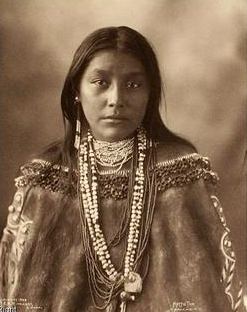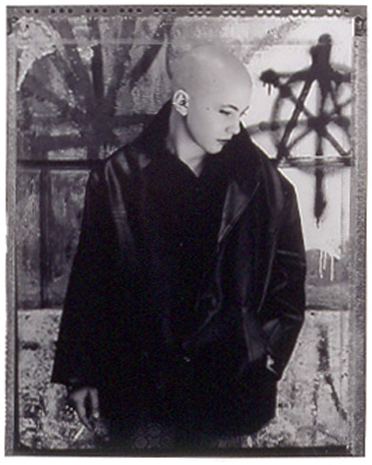Photographers sneak up on people or catch them on the fly.
Walker Evans went so far as to rig his camera so it appeared to be
focused elsewhere for his Subway series, Many Are Called.
Inside-Out: Portrait Photographs from the Permanent Collection at the Henry Art Gallery concentrates on portraits that are collaborative. The subject understands the scrutiny and has prepared a face to meet it.
 Edward Curtis: Among others, Bill Holm defended Curtis against Christopher Lyman’s 1982 debunking study, The Vanishing Race and Other Illusions. which accused him of racism, sexism, nostalgic romanticism and intentional fraud. Lyman’s harsh view has not prevailed. Yes, Curtis traveled with costumes and used them interchangeably when subjects presented themselves as insufficiently colorful. He wanted to reconstruct the past, not document the present.
Edward Curtis: Among others, Bill Holm defended Curtis against Christopher Lyman’s 1982 debunking study, The Vanishing Race and Other Illusions. which accused him of racism, sexism, nostalgic romanticism and intentional fraud. Lyman’s harsh view has not prevailed. Yes, Curtis traveled with costumes and used them interchangeably when subjects presented themselves as insufficiently colorful. He wanted to reconstruct the past, not document the present.
Like Curtis, Marsha Burns believes in engaged contact. In the 1980s and ’90s, she worked in gelatin silver prints or enlarged Polaroids, with subjects
standing against a folded, gray backdrop. Her prints are are an orchestration of
grays, blacks and whites, with the edges from the
contact sheet and sprocket-marks from the film serving as decorative
borders and a homage to the means of her production.
 Also like Curtis, her photos are theatrical presentations, sum points of edifice. They are visual stories whose internal construction delivers meaning. One thinks of Irving Penn’s studio shots of tribal peoples around the globe, not in this show. Burns’ are more intimate than Penn’s, but just as crisp and elegant.
Also like Curtis, her photos are theatrical presentations, sum points of edifice. They are visual stories whose internal construction delivers meaning. One thinks of Irving Penn’s studio shots of tribal peoples around the globe, not in this show. Burns’ are more intimate than Penn’s, but just as crisp and elegant.
In Burns’ view, style is substance, attire is destiny. Seeking to be a medium through which people could tell their own stories, she sought subjects whose bodies speak for them and (unlike Curtis) told them to compose themselves as they wished to be seen. Her lack of cynicism, her belief that portraiture can reveal essential truth, even the idea that there is something called essential truth, put Burns at odds with many of her contemporaries. While they were busy exposing reality as a series of selected fictions, she was after soul, the grace in character.
Her approach has more in common with Thomas Eakins than Cindy Sherman.
Also in the exhibit, curated by Sylvia Wolf, Henry director: Imogen Cunningham, Patrick Faigenbaum, Nan Goldin, Frank A. Rinehart, Benjamin J. Falk, Samuel Montague Fassett, Jim Goldberg, David Octavius Hill, Robert Adamson, Deborah Luster, Fred E. Miller, Nicholas Nixon, Aleksandr Rodchenko and Andy Warhol.
Through Oct. 25.



What happened to Marsha Burns? You use the present tense, but I was unable to find anything about her online.
What happened? Is Bouncing Ball losing its bounce? Usually, we can count on you for links. Instead, you offer a list of unlinked names at the bottom. Do you think they’re all so obvious that no links are necessary or are you tired of helping out?
At least this feels like a review of sorts. Your Henry posts on what’s on view are so short you might as well not have done them.
Thanks for the Henry posts. If I lived in Seattle, I’d visit in a hot hurry.
Hi Andy. You’re right. I usually link to nearly all names and didn’t. It wasn’t that they are too obvious. I ran out of linking gas. Will do better.